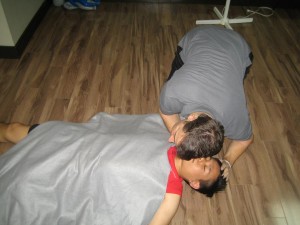As opposed to an ischemic stroke where a blood clot forms and blocks the arteries in the brain, a hemorrhagic stroke happens when there is a weakening of a blood vessel in the brain that eventually ruptures open causing blood to spill into or around the brain. The increased fluid in the brain then leads to swelling and pressure, causing damage to the neurons and tissue in the brain. It may cause irreversible damage to the brain’s functioning.
15% of all cases of strokes are hemorrhagic. However, an ischemic stroke may eventually develop bleeding and become a hemorrhagic stroke.
https://www.youtube.com/watch?v=bp1HRfpOUo0
Types of Hemorrhagic Stroke
There are two types of hemorrhagic stroke:
Intracerebral Hemorrhage
- More common
- Bursting of a blood vessel inside the brain and leakage into the surrounding tissue
- Bleeding leads to cell death of the neurons and the affected part of the brain may stop working correctly
Subarachnoid Hemorrhage
- Less common
- Bleeding in the subarachnoid space, the area between the tissue covering the brain and the brain
- Usually caused by burst aneurysm
Causes of Hemorrhagic Stroke
The most common cause of a hemorrhagic stroke is high blood pressure, which also happens to be the greatest risk factor. Other possible causes are:
- Atriovenous malformation (AVM) – formation of abnormal connections between the arteries and veins of unknown causes
- Injury to the head
- Bleeding disorders
- Blood thinners, such as warfarin (Coumadin)
- Natural – as blood vessels age, they become weaker
Symptoms of Hemorrhagic Stroke
Symptoms of hemorrhagic stroke are not alike in all cases, as symptoms are dependent on which part of the brain is affected. Symptoms of hemorrhagic stroke are similar to those of ischemic stroke, which are:
- Patient would NOT be able to smile equally on both sides or stick one’s tongue out in the center (sudden weakness or numbness of the face, usually on one side only)
- Failure to raise both arms and one arm drifts downwards (sudden weakness or numbness of the arm or leg, especially on one side)
- Abrupt difficulty seeing in one or both eyes
- Slurred speech and has difficulty repeating simple sentences such as “The grass is green.” (Having difficulty either in speaking or understanding speech)
- Sudden loss of balance, coordination, walking or dizziness
- Sudden intense headache with no apparent cause
First Aid Management for Hemorrhagic Stroke
First aid management for hemorrhagic stroke is also similar to all kinds of stroke patients. To learn more about how to properly apply first aid in emergency situations, such as hemorrhagic strokes, enroll in First Aid Classes.
- Assess the level of consciousness of the patient. If the patient is conscious, give care and ensure that the patient is in the position of greatest comfort to him/her. If the patient is unconscious but breathing normally, place the patient to their side in a supported position.
- Call for an ambulance immediately.
- To limit heat loss, cover the patient.
- Do not leave the patient alone at all times. Monitor the patient for changes in condition while waiting for the paramedics. If there is a deterioration observed in the consciousness of the patient, assist the person to their side in a supported position.
A hemorrhagic stroke occurs when there is a brain aneurysm or leakage of blood from a weakened blood vessel that causes blood to spill into or around the brain.

